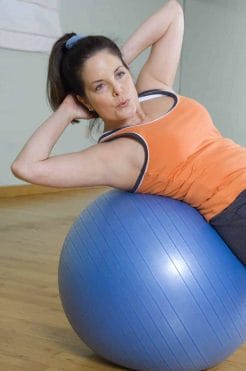
Pilates – exercises and effects
The Pilates is currently one of the is currently one of the most popular workout methods chosen by women. Of course men also train it, but it is the women choose it the most. No wonder, it is a great way to strengthen the whole body, while at the same time providing appropriate relaxation, and what follows – a good well-being. Everyday life is often hard on us and from time to time our bodies need to calm down from time to time. The Pilates helps you to balance between work and rest. What’s more, it enables you to improve the appearance of your figure and can be performed by almost anyone. It is perfect for those who lead a sedentary lifestyle lifestyle and want to break the routine, but do not like to exercise intensively. What is pilates, what effects does it bring and why it is worth training?
Contents
Pilates – what is it?
Pilates is a training method created by Joseph Pilates, who himself suffered from rickets and wanted to overcome his physical limitations. In 1920 he set up a systematic training that helped him develop his range of motion and strengthen his muscles. Regular exercise appealed to him so much that he became an athlete.

During World War I, Pilates worked as a volunteer with disabled people, constructing rehabilitation rehabilitation equipment for them. After the war, he collected what he had and spread his idea on a wider scale. His system of training quickly became popular among Dancers, physiotherapists, surgeons and chiropractors. The method continued to be improved and even today there are various innovative solutions in the field of Pilates.
The Pilates allows you to strengthen the muscles the entire body, combining different training techniques.
Principles of pilates training
The effectiveness of the pilates workout is based on 6 principles that you should follow to get the the results you want.
Breathe
The special breathing technique (inhale air through your nose and out through your mouth) gives you full control over your breathing and improve your own efficiency, ensuring full use of your lungs.
Concentration
Concentrating on each allows us to gain full control over the movement.
Centring
Start each movement from the centre of our body – the abdominal muscles.
Control
It is very important to control each movement, combining it with correct breathing. It is important to be fully awareness of your own body.
Fluidity
Movements performed fluently will help us in achieve harmony and balance.
Accuracy
In pilates quality is more important, and not the quantity of performed movements. We focus fully on technique, performing each gesture with full precision.
Pilates benefits
The pilates workout brings with it a whole range of benefits. Among them are:
- strengthening deep muscles and improving posture;
- Reduced back pain and spinal pain;
- stronger and firmer body;
- increased mobility;
- improved flexibility;
- increased control over your body;
- better strength, muscle endurance and no joint problems;
- improved blood circulation;
- reduced risk of injury and trauma when performing other types of physical activity;
- help in the harmonious development of muscles.
The pilates workout works well as an individual training regimen, as well as an addition to strength training or cardio. It is performed by lovers of running or cycling trips, as it greatly helps to develop the body, so we can get better results in the gym and in the field.
Types of pilates exercises

Since the creation of training by Joseph Pilates, this method has evolved and different variants. Below are 3 of the most common.
Stott Pilates
Combines breathing exercises, stretching and a gentle form of gymnastics. Very easy and pleasant form of exercise, ideal for beginners and those seeking relaxation.
Power Pilates
Combination of gymnastics and calming mind. It is performed using basic exercises exercises (elastic bands, balls, rollers).
Joga Pilates
Combination of yoga and Pilates. Practiced flexibility and form are exercised, combined with regular breathing and constant control over movement.
Pilates – for whom?
Thanks to its great versatility, pilates can be performed by practically everyone. There are very few contraindications for this type of training. W some situations pilates is even recommended.
Pilates for back pain
The Pilates strengthens your back muscles, and relieves strain on the spine. It is highly effective to combat chronic back pain caused by The Pilates Pilates Pilates Pilates Pilates Pilates Pilates Pilates Pilates Pilates Pilates Pilates Pilates Pilates Exercises engage deep muscles which are very important for The exercises engage the deep muscles which are very important in maintaining the correct posture of the body.
Pilates is used as rehabilitation for certain injuries. After an injury, athletes often abandon intensive physical effort after an injury in order to regenerate their strength and damaged body parts while staying in shape.
Pilates for stress and lack of energy
Our everyday lifestyle is conducive to chronic stress. Work and bad weather conditions make us lack energy and desire to live. The pilates can also help us with that. The workout relaxes the muscles and helps calm the mind, which reduces stress levels. Its creator, Joseph Pilates, has experienced the health benefits of the workout as it helped him fight his asthma, among other things. Pilates promotes well-being and can also effectively motivate other physical activities, such as swimming or running, while reducing the risk of injury.
Pilates for beginners
This type of workout will work great for people who have never exercised before. Anyone, who have not been active so far, can start their adventure with sport with sport from Pilates. Exercise set for pilates for beginners will not only help you strengthen your muscles and endurance, but also ensures peace and relaxation. Thanks to many stress-relieving and calming exercises, the pilates is also perfect for those who do not like to exercise on a daily basis. do not like to exercise.
Pilates for weight loss?
Does pilates help you lose weight? If we combine the training system with a healthy diet and do it regularly, of course it will help us to slim and sculpt our figure. Interestingly, in contrast to aerobic training or cardio type HIIT or Tabata, to start doing Pilates, you do not need a good condition and special preparation.
Pilates – contraindications
The Pilates is one of the one of the safest systems of training, but sometimes even here sometimes you need to be careful. People after injuries, serious illnesses and surgeries, before you start to train, Before you start training, you should consult your doctor who will advise you on the type of type of physical activity they can do.
If you are exercising under the supervision of an If we exercise under the supervision of an instructor, it is also worth telling him or her about our If we exercise under the supervision of an instructor it is also a good idea to tell him or her about our ailments and limitations. We should also be careful pregnant women, especially in the first trimester.
Contraindications for practicing Pilates are:
- instability of blood pressure;
- risk of blood clots;
- chiropractic;
- recent bone fractures;
- acute inflammatory conditions;
- recent surgery, especially in the abdomen;
- advanced osteoporosis;
- disc hernia;
- pregnancy (mainly first trimester and high-risk pregnancies).
Check: Exercise during pregnancy – is it safe?
Pilates – examples of exercises

Pilates is a universal workout that includes both relaxation and gymnastic exercises with the use of dumbbells or exercise balls. There are tons of variations, so it can be difficult to come up with a specific workout plan. Below I present some basic exercises that you can do by yourself at home. This is a set for beginners.
Lifting and extending legs in standing position
Standing straight, lift the knee up, Then move your leg back until it is straight. All the while trying to maintain the correct posture. At the beginning At first, you may support yourself on a chair or a pole with one hand, but It is best to balance using your abdominal muscles. It is best to balance using your abdominal muscles. Repeat the movement several times, then do the same on the other leg. then do the same on the other leg.
Cradle
Sit with your legs bent at the knees. Draw your knees up to your chest, tucking your legs under your knees. Hold your thighs underneath your knees. Lift your legs off the floor, take a deep breath, and Roll backwards so that your head does not touch the floor. With an exhalation, return to the starting position. Repeat this movement several times. Repeat this exercise several times.
Raise arms and legs
Get down on one side and kneel with your back straight, Keep your back straight, legs bent at 90 degrees to the knees. Raise your arms and legs. Lift straightened right hand in front of yourself and backwards Keep your left leg straight the whole time. Hold for a few seconds. a few seconds, then return to the starting position and repeat Repeat the movement, changing hands and legs to opposite sides.
Hip lift
Lie down on your back with your arms Place your hands along your body with your legs bent at the knees. Lift Raise your hips, tightening your buttocks. Remain in this position for several seconds. position for a few seconds, then lower your hips back to the mat. Lower your hips back onto the mat. Repeat the movement about 10 times.
The exercises presented above, are the basic scope of Pilates. The more we practice, the higher we can set ourselves. At the beginning it is best to take advice from an instructor, and you will notice that after some time you After some time we will learn to create our own training plans.



